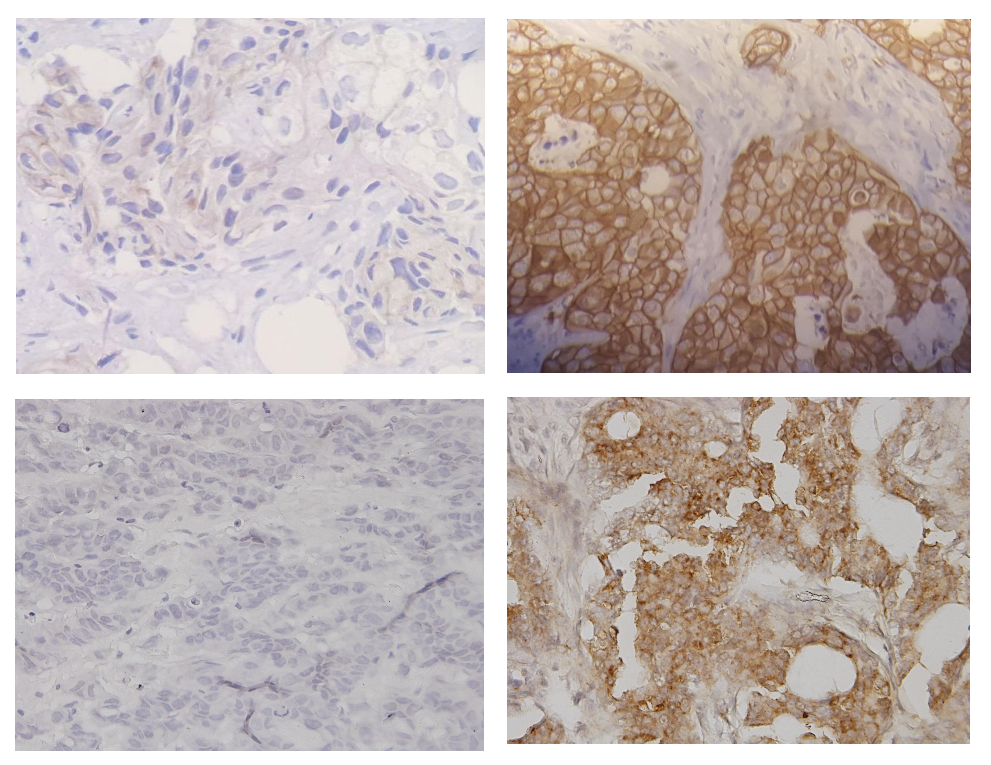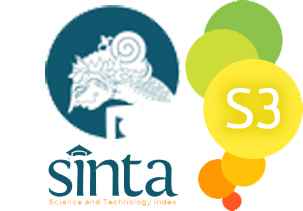Relations of Human Epidermal Growth Factor Receptor 2 (HER2) Expression and E-Cadherin (CDH1) Expression in Breast Cancer Patients
Abstract
The aim of this study is to analyze the relations of Human Epidermal Growth Factor Receptor 2 (HER2) expression and E-Cadherin (CDH1) expression in breast cancer patients. To date, the synergistic effect of this CDH1/HER2 complex is not well clarified. The design of this study was cross-sectional with a total sample of 56 formalin-fixed paraffin tissue blocks that had been examined for HER2. Furthermore, CDHI expression was examined using the Immunohistochemistry staining technique with the Labeled Streptavidin Biotin Complex (LSAB) method. Bivariate analysis was performed using the Spearman correlation test with abnormally distributed data (p>0.05). Of the 56 data on breast cancer patients, most of the patients (87.5%) were diagnosed at the age of ≥40 years. The majority of cancer staging was IIIB, which was 42.9% of the total 56 patients. The study results shows that 80.0% of HER2-positive patients were in the strong CDH1 group. From these data, there is evidence of correlation between HER2 expression and CDH1 expression in breast cancer patients, however this correlation was not significant (p>0.05).
References
Baranwal, S., & Alahari, S. K. (2009). Molecular mechanisms controlling E-cadherin expression in breast cancer. Biochemical and Biophysical Research Communications, 384(1), 6–11. https://doi.org/10.1016/j.bbrc.2009.04.051
Corso, G., Bonanni, B., & Veronesi, P. (2018). Tumor inactivation of E-cadherin: a new tool for breast cancer treatment? Annals of Translational Medicine, 6(S1), S6–S6. https://doi.org/10.21037/atm.2018.08.45
Darwin, E., Elfi, E. F., & Elvira, D. (2017). Endotel: Fungsi dan Disfungsi. Padang: Andalas University Press.
Dey, N., Leyland-Jones, B., & De, P. (2016). HER2 Signaling Network in Advanced Breast Cancer: Opportunities for Combination Therapies. In N. Dey, P. De, & B. Leyland-Jones (Eds.), PI3K-mTOR in Cancer and Cancer Therapy (1st ed., pp. 231–261). Cham: Springer International Publishing.
ElMoneim, H. M. A., & Zaghloul, N. M. (2011). Expression of e-cadherin, n-cadherin and snail and their correlation with clinicopathological variants: An immunohistochemical study of 132 invasive ductal breast carcinomas in Egypt. Clinics. https://doi.org/10.1590/S1807-59322011001000015
Fink, M. Y., & Chipuk, J. E. (2013). Survival of HER2-Positive Breast Cancer Cells: Receptor Signaling to Apoptotic Control Centers. Genes and Cancer, 4(5–6), 187–195. https://doi.org/10.1177/1947601913488598
Hammer, C., Fanning, A., & Crowe, J. (2008). Overview of breast cancer staging and surgical treatment options. Cleveland Clinic Journal of Medicine, 75(Suppl_1), S10–S10. https://doi.org/10.3949/ccjm.75.Suppl_1.S10
Harahap, W. A., & Khambri, D. (2018). Outcomes of breast cancer treatment in West Sumatera-Indonesia. European Journal of Cancer, 92, S27. https://doi.org/10.1016/s0959-8049(18)30307-1
He, L., Lv, Y., Song, Y., & Zhang, B. (2019). The prognosis comparison of different molecular subtypes of breast tumors after radiotherapy and the intrinsic reasons for their distinct radiosensitivity. Cancer Management and Research, 11, 5765–5775. https://doi.org/10.2147/CMAR.S213663
Horne, H. N., Oh, H., Sherman, M. E., Palakal, M., Hewitt, S. M., Schmidt, M. K., … Figueroa, J. D. (2018). E-cadherin breast tumor expression, risk factors and survival: Pooled analysis of 5,933 cases from 12 studies in the Breast Cancer Association Consortium. Scientific Reports, 8(1), 6574. https://doi.org/10.1038/s41598-018-23733-4
Ingthorsson, S., Andersen, K., Hilmarsdottir, B., Maelandsmo, G. M., Magnusson, M. K., & Gudjonsson, T. (2016). HER2 induced EMT and tumorigenicity in breast epithelial progenitor cells is inhibited by coexpression of EGFR. Oncogene, 35(32), 4244–4255. https://doi.org/10.1038/onc.2015.489
Iqbal, N., & Iqbal, N. (2014). Human Epidermal Growth Factor Receptor 2 (HER2) in Cancers: Overexpression and Therapeutic Implications. Molecular Biology International, 2014, 1–9. https://doi.org/10.1155/2014/852748
Januardi, Y., Pualilin, D., Kadir, I., & Prihantono, P. (2019). Relationship Among Expression of E-Cadherin and HER-2/Neu with Metastasis in Breast Cancer. International Journal of Surgery and Medicine, (0), 1. https://doi.org/10.5455/ijsm.ecadherin-her2-metastatic-breast-cancer
Kalluri, R., & Weinberg, R. A. (2009). The basics of epithelial-mesenchymal transition. Journal of Clinical Investigation, 119(6), 1420–1428. https://doi.org/10.1172/JCI39104
Li, Z., Yin, S., Zhang, L., Liu, W., & Chen, B. (2017). Prognostic value of reduced E-cadherin expression in breast cancer: a meta-analysis. Oncotarget, 8(10), 16445–16455. https://doi.org/10.18632/oncotarget.14860
Pang, H., Lu, H., Song, H., Meng, Q., Zhao, Y., Liu, N., … Cai, L. (2013). Prognostic values of osteopontin-c, E-cadherin and β-catenin in breast cancer. Cancer Epidemiology. https://doi.org/10.1016/j.canep.2013.08.005
Panigoro, S. S., Karsono, R., & Sari, L. (2017). E-cadherin and Vimentin as Predictors of Resistance to Preoperative Systemic Therapy in Patients with Advanced Breast Cancer. EJournal Kedokteran Indonesia, 4(3), 149–155. https://doi.org/10.23886/ejki.4.7109.149-55
Singhai, R., Patil, V., Jaiswal, S., Patil, S., & Patil, M. (2011). E-Cadherin as a diagnostic biomarker in breast cancer. North American Journal of Medical Sciences, 3(5), 227–233. https://doi.org/10.4297/najms.2011.3227
Union for International Cancer Control (UICC). (2019). New Global Cancer Data: GLOBOCAN 2018. Retrieved October 13, 2019, from https://www.uicc.org/news/new-global-cancer-data-globocan-2018
Vu, T., & Claret, F. X. (2012). Trastuzumab: Updated mechanisms of action and resistance in breast cancer. Frontiers in Oncology, 2 JUN. https://doi.org/10.3389/fonc.2012.00062























